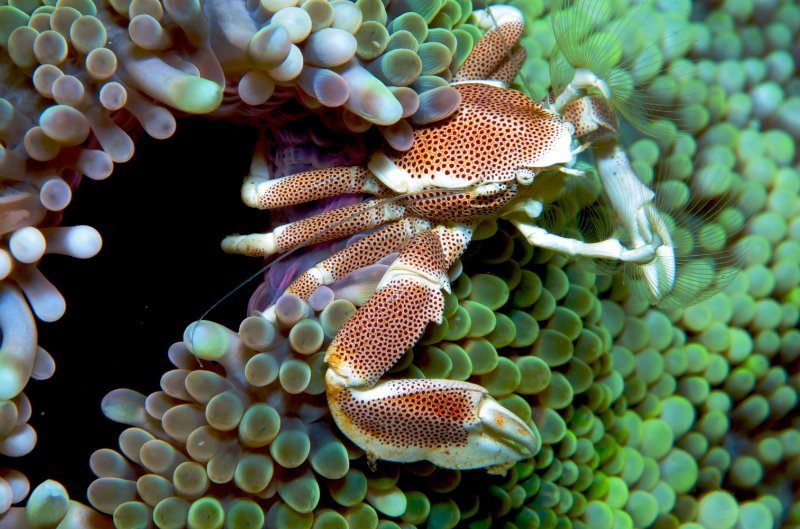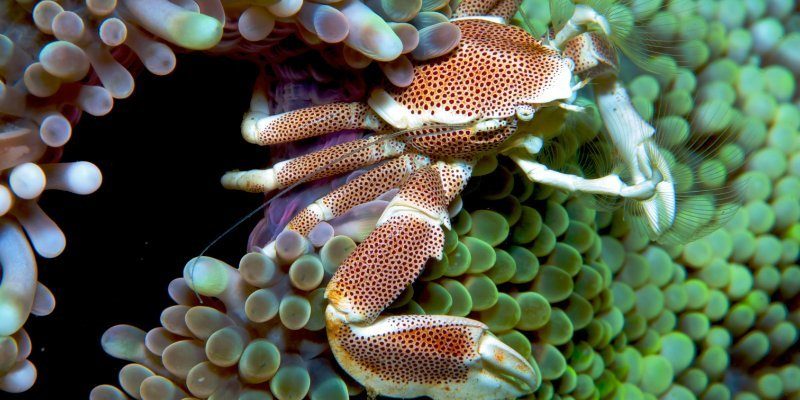
If you’ve ever dipped your toes into the ocean or scrolled through videos of vibrant marine life, you might have come across the fascinating Anemone Crab. These little crustaceans might look unassuming at first, but they have a world of wonders hidden within their tiny shells. Think of them as the ocean’s best-kept secret, living among the colorful tentacles of sea anemones. They have a symbiotic relationship that’s as interesting as it is essential. Imagine finding a cozy home in a bustling city, where everything you need is just around the corner—this is exactly how anemone crabs feel within their anemone homes.
These lively crabs are not just adorable; they play a vital role in their ecosystems. You might be curious about their habits, diet, or what makes them tick. Let’s dive deeper into the remarkable world of anemone crabs and uncover the fascinating details of their lives. From their habitat to their unique behaviors and interactions with their environment, there’s so much to learn about these charming crustaceans.
Physical Characteristics
The Anemone Crab stands out due to its unique physical traits. Typically, they boast a small, round body adorned with a hard shell that helps protect them from predators. Their size can vary, with most crabs measuring about 3 to 5 centimeters across. When you see one in its natural habitat, you’ll notice the vibrant colors—ranging from browns and greens to yellows—that help them blend seamlessly into the anemones they inhabit.
These crabs also have a pair of large pincers, which they use for various activities, like feeding and defending themselves. Their claws are not just for show; they’re essential tools for foraging and handling anemone tentacles without getting stung. Imagine trying to pick up a delicate flower without damaging it—that’s how careful these crabs need to be. Their nimble movements allow them to navigate their environment, showcasing an elegance that contrasts with their rugged surroundings.
Another notable feature is their specialized adaptations to life in anemones. The crabs have developed a mutualistic relationship where they receive protection from predators in exchange for providing food scraps and keeping the anemone clean. You could say they’re the unlikely partners in a beautifully choreographed dance of survival.
Habitat
Anemone crabs are mostly found in the warm waters of the Indo-Pacific region. These areas are rich in coral reefs and provide the ideal conditions for both the crabs and their anemone hosts. Much like how you might prefer familiar surroundings, these crabs thrive in environments where they have access to their favorite anemones.
The interaction between the anemone crab and its host is crucial for survival. The crab takes refuge among the stinging tentacles of the anemone, which gives it protection from predators like larger fish. This natural defense mechanism is similar to how certain birds build their nests in thorny bushes; the stakes are high, yet the rewards outweigh the risks. You might be wondering why the anemone doesn’t harm the crab—well, these little crustaceans have developed a unique way to avoid the anemone’s sting, thanks to a special mucus layer that coats their bodies.
While anemone crabs enjoy their cozy homes, they are also adaptable. They can inhabit various coral reef ecosystems, showing their versatility in finding suitable living conditions. Whether they’re nestled in a bright orange clownfish sea anemone or a less colorful variant, these crabs always manage to find their place amidst the vibrant underwater community.
Diet and Feeding Habits
The diet of the Anemone Crab is fascinating and varied. These crabs are omnivorous, meaning they consume both plant and animal matter. In their natural habitat, they primarily feed on small organisms like zooplankton, leftovers from their anemone companions, and detritus. Picture them as tiny scavengers, always on the lookout for their next meal while ensuring their anemone home is kept tidy.
Feeding usually occurs at night, when these crabs venture out from the safety of their anemones. They have developed clever techniques for foraging, often using their pincers to sift through sand and debris on the seafloor. Imagine a child digging in the sand, excitedly searching for treasures; that’s the essence of how anemone crabs explore their surroundings.
One interesting aspect of their feeding habits is their relationship with the anemone. As they feed on the anemone’s leftovers, they contribute to the health of their host by preventing waste buildup. It’s a classic example of “you scratch my back, I’ll scratch yours.” This mutualistic relationship significantly impacts the local ecosystem, showcasing how every creature, no matter how small, plays a vital role in maintaining the balance of marine life.
Behavior and Social Structure
The behavior of anemone crabs is captivating and tells us a lot about their social structure. Typically, they are solitary creatures. However, they can sometimes be found sharing their anemone homes with other crabs or fish. It’s not a crowded party, but a well-balanced coexistence that benefits everyone involved. Think of it as a peaceful neighborhood where neighbors get along just fine.
One fascinating behavior to note is the crab’s ability to defend its territory. When threatened, the anemone crab will use its pincers to fend off intruders, showcasing a surprising amount of bravery for its size. They may appear small and vulnerable, but they have developed tactics that enable them to stand their ground against much larger opponents. It’s a wonderful reminder that size doesn’t always dictate strength.
Another intriguing aspect of their behavior is their grooming habits. Anemone crabs often spend time cleaning their anemone companion by removing debris and parasites. This not only keeps their home tidy but also strengthens their bond. Imagine roommates who help each other out—it’s a win-win situation. This mutual care is essential for maintaining the health of both the crab and the anemone, highlighting their interconnected lives under the sea.
Conservation Status
The conservation status of the Anemone Crab is something that requires our attention. While not currently endangered, their habitats are threatened due to climate change, pollution, and habitat destruction. Coral reefs, where these crabs thrive, are incredibly sensitive ecosystems that are rapidly declining worldwide. It’s much like a delicate tapestry—once one thread starts to unravel, the entire structure can begin to fall apart.
Efforts to protect these fascinating creatures are essential. Organizations focused on marine conservation are working to mitigate damage to coral reefs and raise awareness about the importance of preserving marine biodiversity. You might wonder how you can help—simple actions like reducing plastic use, supporting sustainable fishing practices, or participating in beach cleanups can make a real difference.
Moreover, understanding the vital role that anemone crabs play in their ecosystems can encourage more people to take action. As we learn more about these charming creatures, we foster a sense of responsibility toward their survival. After all, every little bit counts when it comes to protecting our oceans and the incredible life they hold.
Interesting Facts
| Size: | 3 to 5 centimeters |
| Habitat: | Indo-Pacific region, coral reefs |
| Diet: | Omnivorous; feeds on zooplankton and anemone leftovers |
| Behavior: | Solitary but sometimes shares habitat |
| Conservation Status: | Not endangered, but habitats are threatened |
FAQ
Where can I find Anemone Crabs?
Anemone crabs are typically found in the warm waters of the Indo-Pacific region. They thrive in coral reefs where they can find their beloved anemone hosts. If you’re ever snorkeling or diving in these areas, keep your eyes peeled for these tiny creatures hiding among the colorful tentacles of anemones.
Do Anemone Crabs sting?
No, anemone crabs do not sting. Instead, they have developed a mutualistic relationship with their anemone hosts, which do have stinging tentacles. The crabs possess a special mucus coating that protects them from the anemone’s sting, allowing them to live safely among the tentacles while receiving protection in return.
What do Anemone Crabs eat?
Anemone crabs are omnivores, enjoying a diet that includes zooplankton, algae, and scraps from their anemone hosts. They are skilled foragers, often scavenging for food at night when they venture away from the safety of their anemone. This feeding behavior helps keep their living space clean and healthy.
How do Anemone Crabs reproduce?
Anemone crabs reproduce through a process known as external fertilization. The female crab carries the fertilized eggs on her abdomen until they hatch into tiny larvae. These larvae drift with the currents until they settle down near suitable anemones, starting the cycle anew. This breeding strategy increases the chances of survival for the next generation.
Are Anemone Crabs aggressive?
Anemone crabs are generally not aggressive; instead, they tend to be quite shy creatures. When threatened, they will use their pincers to defend themselves, but they prefer to retreat to the safety of their anemones when danger approaches. Their behavior reflects a survival strategy of avoiding confrontation whenever possible.
How long do Anemone Crabs live?
In the wild, anemone crabs typically live for about 5 to 7 years. However, their lifespan can vary based on environmental conditions and the presence of predators. Ensuring they have a healthy habitat with minimal threats can help them reach their maximum lifespan.
Can Anemone Crabs change their anemone host?
Yes, anemone crabs can change their anemone host if needed. While they often prefer to stay with a specific anemone, they are capable of relocating to a different host if their current one becomes unsuitable or if they find a better option nearby. This adaptability is key to their survival.
What is the scientific name of the Anemone Crab?
The scientific name for the anemone crab is Neopetrolisthes maculatus. This species belongs to the family of porcelain crabs, which includes various other species that share similar habitats and behaviors. Understanding their scientific classification can help conservationists in their efforts to study and protect these amazing creatures.
Can you keep Anemone Crabs in an aquarium?
Yes, anemone crabs can be kept in aquariums, but it’s essential to replicate their natural environment as closely as possible. This means providing a suitable anemone for them to live in, as well as maintaining water quality and temperature. Keep in mind that they might require specific care to thrive. Do thorough research before adding them to your saltwater tank.

